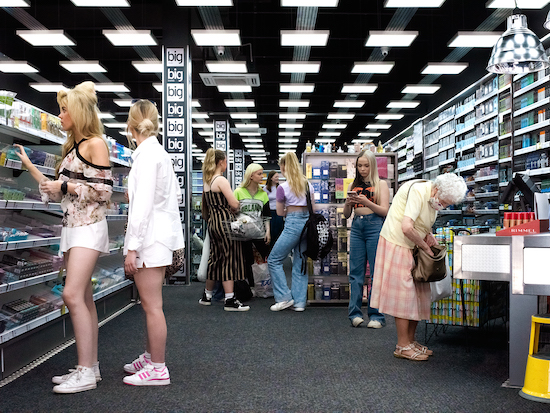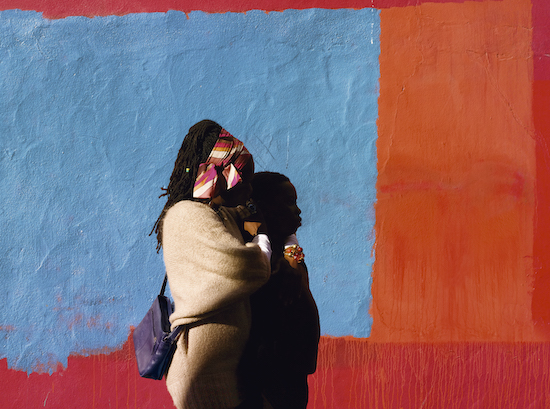Hannah Starkey, Untitled, August 2012, 2012. C-type photographic print mounted on aluminium. Courtesy of the artist,
Maureen Paley, London and Tanya Bonakdar Gallery, New York / Los
Angeles
In Real Life is the first major survey of Hannah Starkey’s photography and it’s a cracker. Starkey was born in 1971 and is from Belfast (so forgive the Frank Carson reference). She lived through much of the civil war there – let’s not use that weasel term ‘The Troubles’ – and Ulster is the backdrop to one of the best images here, Untitled May 2022, a land where peace now reigns.
We see a street scene, the sky a threatening indigo, with a row of terraced houses to our left, the gable end of which is decorated by an elaborate Loyalist mural memorialising UDA losses. Two lumpen male figures are painted in grey on either side of a wreath. Their dull seriousness is in stark contrast to the main figure in the photograph, a young woman striding into a (one hopes) brighter future. The girl has her back to us as. Her long Titian red locks flare in the breeze. She wears a pink anorak and matching knee-high platform boots, short skirt and sky-blue leg warmers. In short, she’s the life-force itself rejecting the mawkish mourning of the dead. Even the seagulls seem intimidated by her vivacity. Across the road there’s a single male figure in the distance: he’s denim clad and capped and may or may not be a threat. Another mural shows George Best in mid-dribble. Ulstermen are not all bad.
Starkey’s subjects are women, women in the modern world negotiating urban spaces, a territory only made tentatively available since the still relatively recent invention of electric street lighting. She’s particularly good at capturing women in moments of unobserved focus, the body and mind seen in what critic Michael Fried would call the abstracted state as opposed to the theatricality of posing. The effect is akin to Vermeer’s canvases with their loud stillness.
One of the earliest works here, Untitled, May 1997, revels in a young woman’s interiority. The scene is an everyday café with its formica table and chairs, its red plastic tomato sauce dispenser. The woman has Italian looks and places her hand on a mirror to touch – what? A moth, a stain on the glass? We study her far-away look as intently as another diner – another woman – this time older, her hair in curlers, her coffee cup half-raised to her lips. We can only guess at what they’re both thinking. And that’s the point of the work. Starkey is great at setting up visual short stories that beg exposition, speculative fictions. She encourages us to make up the narrative for ourselves.

Hannah Starkey, Beauty Shop, 2022. 2022. C-type photographic print mounted on aluminium. Courtesy of the artist,
Maureen Paley, London and Tanya Bonakdar Gallery, New York / Los
Angeles
Here’s another café scene, this time in what looks like Hoxton (Untitled, October 1998) where a mum and daughter share a bottle of Coke. Mum has her back to us, wears a large crystal earring in one ear, cradles a ciggie. From the daughter’s perspective it would appear that the mother is lecturing her. The younger is in her early teens and wears an Arsenal top. She rests her right cheek on her right fist, elbow on the table, and looks fantastically bored, judgmental even; maybe she’s had enough of her mother’s hypocrisy. Maybe she’s thinking: this is what I might turn out like.
Starkey’s worlds are often hidden from male view: four middle-aged women confer under a single lamp outside a school complex in Untitled, August 1999. We’re privy to some support group perhaps, looking for solutions to an intractable problem, some sectarian side-effect caused by Ulster male toxicity, no doubt. The halo of light sits above one of the secular saints. She’s dressed in a leopard-spotted dress hinting that the ladies are not averse to a bit of fun, a bit of the craic.
Another glimpse into a private world is provided by the strikingly beautiful Untitled, September 2006, where the silhouette of a pregnant woman is outlined as she stands solitary in the blue waters of a modernist swimming pool, an image as gravid in meaning as its subject. The curve of her belly is mirrored in the art deco-like swoop of the pool. A lone wheelbarrow sits on the grass outside. Serene, she seems ready to carry her weight to term.

Hannah Starkey, Bus Stop, 2022. 2022.C-type photographic print mounted on aluminium. Courtesy of the artist, Maureen Paley, London and Tanya Bonakdar Gallery, New York / Los Angeles
There’s gentle humour here too, as with Beauty Shop, 2022, where a group of teenage girls in trainers and t-shirts browse the shelves for product and consult their mobiles: there’s the incessant focus again that Michael Fried talk of, the absence of theatricality. None look at the camera. We’re the privileged observer. On the far right though, crouched over at the counter, is an osteoporotic geriatric woman bent over her handbag, searching for her purse; she’s the only one masked. The youngsters are blithely indifferent to her hunt and to COVID. They are fixed in the immediacy of youth: concerned only about the now, how they look, what they are doing tonight. And yet age happens. It’s easy to read this as a contemporary twist on Lucas Cranach’s imagery of vanity and ageing. Maudlin, you think too of Shakespeare’s line in Cymbeline about golden girls who must, as chimney-sweepers, come to dust.
We should add that Starkey is a great colourist. Untitled, May 2004 is a mouth-watering scene in a confectionery where the shop assistants are reflected in mirrors. Starkey is a big fan of mirrors where we are caught unawares (there’s that Fried-ian anti-theatricality at work again). Lines of petit fours are displayed as exquisitely as a Wayne Thiebaud oil painting with their pistachio creams, brown chocolate layers, pink glazings, and lemon coatings.
More recent imagery arrives with agitprop scenes from the Youth Strike 4 Climate Protest in 2019, and the celebrations following the victory of the English woman’s football team earlier this year. Confident women with their banners demanding equal rights, as with ‘I can’t believe we’re still protesting this shit’, Woman’s March, London 2017.
And if the imagery wasn’t enough excellence to be getting on with there’s a terrific Wendy Erskine tale, too, in the gorgeous illustrated catalogue that pairs the exhibition. Erskine and Starkey are both great at stories. And that’s because it’s (cough) the way they tell them.
Hannah Starkey, In Real Life, is at The Hepworth, Wakefield, until 30 April 2023.


